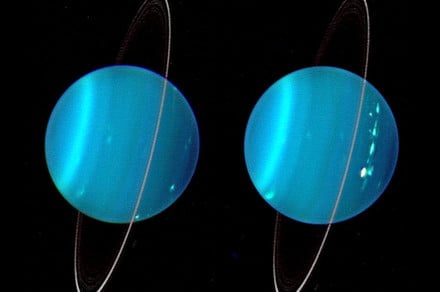Composite image of Uranus’s atmosphere and rings at radio wavelengths, taken with the ALMA array in December 2017. UC Berkeley image by Edward Molter and Imke de Pater
New images reveal the rings around Uranus, almost invisible to most telescopes, shining brightly as they reflect light in the visible and near-infrared range. But there’s a strange puzzle about them — why they don’t contain any small dust-sized particles.
Uranus’ rings are different from the most famous rings in our Solar System, those seen around Saturn, which are large and icy. “Saturn’s mainly icy rings are broad, bright and have a range of particle sizes, from micron-sized dust in the innermost D ring, to tens of meters in size in the main rings,” Imke de Pater, a UC Berkeley professor of astronomy, explained in a statement. “The small end is missing in the main rings of Uranus; the brightest ring, epsilon, is composed of golf ball-sized and larger rocks.”
The scientists are still trying to understand the epsilon ring around Uranus in particular. “We already know that the epsilon ring is a bit weird, because we don’t see the smaller stuff,” graduate student Edward Molter said in the same statement. “Something has been sweeping the smaller stuff out, or it’s all glomming together. We just don’t know. This is a step toward understanding their composition and whether all of the rings came from the same source material, or are different for each ring.”
The images showing the thermal emissions of the rings were captured using the Atacama Large Millimeter/submillimeter Array (ALMA) and the Very Large Telescope (VLT), which also allowed the scientists to measure the temperature of the rings for the first time. They were found to be a chilly 77 Kelvin (-320 F).
The image shows the dark bands in Uranus’ atmosphere which indicate the presence of molecules that absorb radio waves such as hydrogen sulfide gas. The bright yellow dot on the right of the planet is the north polar spot, containing few of these absorbing molecules. The polar spot appears on the right of the image because Uranus is tilted almost completely on its side.
Images of the Uranian ring system captured at different wavelengths by the ALMA and VLT telescopes. The planet itself is masked since it is very bright compared to the rings. Images by Edward Molter, Imke de Pater, Michael Roman and Leigh Fletcher, 2019
To create the composite image, the ring system was imaged at different wavelengths from 3mm down to 19μm (the μm stands for micrometers, which are one millionth of a meter). This showed that the rings of Uranus are narrow and lacking in dust-sized particles — instead the rings are made up of centimeter-sized rocks, with bands of dust between the rings. So far, 13 rings have been counted in total.
The paper is available to view on pre-publication archive arXiv.
Editors’ Recommendations
- Milky Way’s supermassive black hole is wrapped in a vast mantle of cool gas
- Seeing the unseeable: Astronomers capture historic first image of a black hole
- Unfriendly exoplanet is stormy, blistering hot, and full of carbon monoxide
- Supermassive black hole resides inside a supermassive galaxy
- The grainy texture of Saturn’s rings reveals clues to their origins

